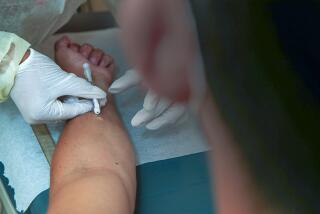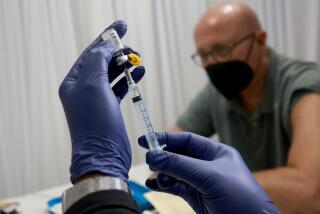Capitol Workers Line Up to Get Anthrax Shots Despite Concerns
- Share via
WASHINGTON — Anthrax vaccinations began Thursday at the U.S. Capitol, where 50 to 60 House and Senate staffers, police officers and other employees lined up for the controversial treatment.
Government officials announced earlier this week that 3,000 doses of vaccine would be made available to individuals exposed to anthrax in the recent attacks. The move was prompted by concerns that the recommended 60-day course of antibiotics, which ended for many in Washington, D.C., this week, might not have killed all the anthrax spores in those most directly exposed.
Health officials have also learned that the exposure may have been much more severe than initially thought. Late Thursday, the Centers for Disease Control and Prevention released a study of the anthrax exposure in the Brentwood mail-sorting facility in Washington that revealed higher levels of contamination than previously believed. The Brentwood facility handled the anthrax-filled letter sent to Senate Majority Leader Tom Daschle (D-S.D.).
“We already knew it was terribly contaminated,” said the CDC’s Dr. Rosemary Sokas, who added that the air hoses used to clean the sorting machines helped to spread large numbers of spores through the building.
Health officials stressed that they were not recommending a specific course of action but were simply laying out options for those who had contact with contaminated letters, worked in areas where someone developed inhalation anthrax or worked in anthrax-contaminated areas. The options include an additional 40-day course of antibiotics or a combination of additional antibiotics and vaccinations, CDC officials said.
Concerns over the safety and efficacy of the vaccine persist, and Washington Mayor Anthony A. Williams advised against vaccination.
“The Department of Health does not recommend investigational post-exposure prophylaxis with anthrax vaccine at this time,” the mayor said in a prepared statement.
Williams said those who were potentially exposed to anthrax should complete their 60-day course of antibiotics and “monitor their health and continue to be alert to signs and symptoms of the disease.”
The vaccine administered Thursday does not contain the anthrax bacteria but is designed to stimulate the immune system to fight off the disease. Until now, only members of the military and a small number of individuals who could be exposed to anthrax, such as research scientists and veterinarians, have been given the vaccine. For full protection, additional doses are needed two and four weeks after the initial dose.
Navy Cmdr. Greg Martin, who advises the Capitol physician’s office on infectious diseases, said that the vaccination recommendation was based on decades of animal studies and available information about human exposure. He said that studies from the 1950s to the early 1990s found spores in the bodies of test animals more than 60 days after exposure.
Martin said an additional 40-day course of antibiotics was an alternative for individuals concerned about the potential adverse effects of the vaccination.
A U.S. Postal Service spokesman said that the CDC would meet with postal workers in Washington and Hamilton Township, N.J., beginning today.
Five people, including two postal workers at the Brentwood facility, have died of inhalation anthrax. At least 13 others have become ill. Both the Daschle letter and another anthrax-laced letter sent to Sen. Patrick J. Leahy (D-Vt.) that was discovered in quarantined mail bore a Hamilton Township postmark.
Some postal workers have complained from the beginning that they have been given little information about the attacks and the potential for danger. They have also complained about inequities in treatment. A Postal Service spokesman said Thursday that vaccinations for postal workers would not be available until Thursday at the earliest.
Alan C. Ferranto, health and safety director for the National Assn. of Letter Carriers, said last week that postal workers may be more at risk for the adverse effects of the vaccine.
“Postal workers average middle age; they have all kinds of various things that they live with, from diabetes to whatever,” Ferranto said.
*
Times staff writer Megan Garvey contributed to this report.
More to Read
Sign up for Essential California
The most important California stories and recommendations in your inbox every morning.
You may occasionally receive promotional content from the Los Angeles Times.













